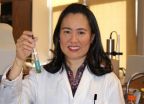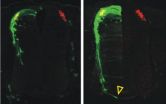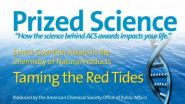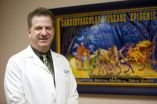(Press-News.org)
VIDEO:
University of Missouri researchers have created a new test for salmonella in poultry and eggs that will produce faster and more accurate results than most currently available tests.
Click here for more information.
COLUMBIA, Mo. –Earlier this year, an outbreak of salmonella caused by infected eggs resulted in thousands of illnesses before a costly recall could be implemented. Now, University of Missouri researchers have created a new test for salmonella in poultry and eggs that will produce faster and more accurate results than most currently available tests. The new test could have prevented the contaminated eggs from being shipped to stores.
"Processors and consumers will benefit from the speed and sensitivity of the new test's results," said Azlin Mustapha, associate professor of food science in the College of Agriculture, Food and Natural Resources. "This will keep companies from shipping contaminated products, and thus, keep salmonella infected products out of consumers' hands."
Salmonella is the most common cause of food poisoning in the United States, according to the Centers for Disease Control. Salmonellosis, the disease caused by salmonella, causes diarrhea, vomiting, fever, abdominal cramps and, in severe cases, death. Mustapha said salmonella testing in poultry is important because it persists in birds' spleens and reproductive tracts. An infected bird passes the infection on to all of its eggs.
The most commonly used testing method for salmonella can take up to five days to produce results. Mustapha's research allows scientists to use a process, known as polymerase chain reaction (PCR), which can cut testing time to as little as five to 12 hours. PCR-based testing methods for salmonella have been available for use by the food industry for years, but current methods often produce false-positive results because they do not differentiate between live and dead salmonella, thus skewing the accuracy of the test. Only live salmonella cells trigger salmonellosis.
Mustapha modified the PCR test by adding a dye to the test sample. The dye is absorbed by dead salmonella cells; thus, the PCR test can ignore the dead cells. Mustapha's modification lets food scientists use the PCR test to capitalize on its speed, selectivity and sensitivity, but avoid false-positive tests by differentiating between dead and live cells.
The reduced testing time would enable companies to have accurate test results before a product is shipped. With current tests, food could be in stores before salmonella test results are available. This new technology will enable companies to avoid costly recalls and keep consumers safe.
Mustapha said both companies and testing agencies could use the testing process she has developed. Companies must make an initial investment in a PCR instrument and train personnel to use it. However, she said the system requires less labor and time than conventional testing techniques. A similar process developed by Mustapha to detect E. coli in ground beef has been adopted by the Missouri Department of Agriculture.
INFORMATION:
Mustapha worked with Luxin Wang, a graduate student in the food science program. Their research results were published recently in the Journal of Food Science.
MU scientist develops salmonella test that makes food safer, reduce recalls
2010-11-23
ELSE PRESS RELEASES FROM THIS DATE:
Cutting-edge salivary diagnostics research presented at AADR 3rd Fall Focused Symposium
2010-11-23
Alexandria, Va. – The American Association for Dental Research (AADR) held its 3rd Fall Focused Symposium on November 12-13, in the Washington, DC, area. This year, the theme was the fast-moving field of Salivary Diagnostics, with a focus on Scientific & Clinical Frontiers. The symposium was sold-out, but AADR also offered a live Webinar broadcast of the oral sessions.
AADR created the Fall Focused Symposium under the objective to provide networking opportunities and exchange of ideas, and to offer small regional symposia focused on cutting-edge technology and techniques. ...
Speed heals
2010-11-23
Both the rate and direction of axon growth in the spinal cord can be controlled, according to new research by USC College's Samantha Butler and her collaborators.
The study, "The Bone Morphogenetic Protein Roof Plate Chemorepellent Regulates the Rate of Commissural Axonal Growth," by Butler; lead researcher Keith Phan and graduate students Virginia Hazen and Michele Frendo of USC College; and Zhengping Jia of the University of Toronto, was published online in the November 17 issue of the Journal of Neuroscience.
Butler, assistant professor of biological sciences, found ...
New tool detects Ebola, Marburg quickly, easily
2010-11-23
BOSTON (11-22-10) -- Boston University researchers have developed a simple diagnostic tool that can quickly identify dangerous viruses like Ebola and Marburg. The biosensor, which is the size of a quarter and can detect viruses in a blood sample, could be used in developing nations, airports and other places where natural or man-made outbreaks could erupt.
"By enabling ultra-portable and fast detection, our technology can directly impact the course of our reaction against bio-terrorism threats and dramatically improve our capability to confine viral outbreaks," said Assistant ...
Ultrathin alternative to silicon for future electronics
2010-11-23
There's good news in the search for the next generation of semiconductors. Researchers with the U.S. Department of Energy's Lawrence Berkeley National Laboratory (Berkeley Lab) and the University of California (UC) Berkeley, have successfully integrated ultra-thin layers of the semiconductor indium arsenide onto a silicon substrate to create a nanoscale transistor with excellent electronic properties. A member of the III–V family of semiconductors, indium arsenide offers several advantages as an alternative to silicon including superior electron mobility and velocity, ...
Hybrid tugboat cuts emissions, University of California, Riverside study shows
2010-11-23
RIVERSIDE, Calif. (www.ucr.edu) --A new study by University of California, Riverside scientists of what is believed to be the world's only hybrid electric tugboat found that the vessel is effective in reducing emissions at the Ports of Los Angeles and Long Beach.
Researchers at the UC Riverside College of Engineering Center for Environmental Research and Technology (CE-CERT) demonstrated the hybrid electric tugboat reduces emissions of soot by about 73 percent, oxides of nitrogen (which help cause smog) by 51 percent, and carbon dioxide, which contributes to global warming, ...
Overweight primarily a problem among wealthier women in low- to middle-income countries
2010-11-23
Boston, MA – A new study from the Harvard School of Public Health (HSPH) finds that high body mass index (BMI) in developing countries remains primarily a problem of the rich. The findings suggest that the shift towards overweight and obesity among the poor that has already happened in wealthier countries has not yet happened in developing countries.
The study appears in an advance online edition of the American Journal of Clinical Nutrition and will appear in an upcoming print edition.
"Previous research on the increasing overweight and obesity burden in developing countries ...
Mayo Clinic study finds aggressive surgery is best for children with brain tumors
2010-11-23
ROCHESTER, Minn. -- A new Mayo Clinic study (http://newsblog.mayoclinic.org/2008/12/03/brain-tumors-best-treatments-for-long-term-survival/) found that children with low-grade brain tumors (gliomas) (http://www.mayoclinic.org/brain-tumors/) who undergo aggressive surgery to completely remove the tumor have an increased chance of overall survival. If complete removal is not possible, adding radiation therapy to a less complete surgery provides patients with the same outcomes as a complete removal. This study was presented at the Society for NeuroOncology Annual Scientific ...
New American Chemical Society Prized Science video focuses on shrinking the computer chip
2010-11-23
WASHINGTON, Nov. 22, 2010 — The science that helped make today's smartphones and iPods smaller but more powerful than yesterday's desktop computers highlights the latest episode in the American Chemical Society (ACS) Prized Science video series.
The new high-definition video, released today, focuses on IBM chemist Robert Miller, winner of the 2010 ACS Award for Chemistry of Materials. Miller developed materials that helped pack more transistors onto each computer chip, those postage stamp-size slivers of silicon that make up the brains of computers and other electronic ...
University of Minnesota engineering researcher finds new way to fight antibiotic-resistant bacteria
2010-11-23
New findings by civil engineering researchers in the University of Minnesota's College of Science and Engineering shows that treating municipal wastewater solids at higher temperatures may be an effective tool in the fight against antibiotic-resistant bacteria.
Heating the solid waste to 130 degrees Fahrenheit (55 degrees Celsius) was particularly effective in eliminating the genes that confer antibiotic resistance. These genes are used by bacteria to become resistant to multiple antibiotics, which are then known as "superbacteria" or "superbugs."
The research paper ...
The not-so-sweet truth about sugar -- a risk choice?
2010-11-23
More and more people have become aware of the dangers of excessive fructose in diet. A new review on fructose in an upcoming issue of the Journal of the American Society of Nephrology (JASN) indicates just how dangerous this simple sugar may be.
Richard J. Johnson, MD and Takahiko Nakagawa, MD (Division of Renal Diseases and Hypertension, University of Colorado) provide a concise overview of recent clinical and experimental studies to understand how excessive amounts of fructose, present in added sugars, may play a role in high blood pressure, diabetes, obesity, and ...



